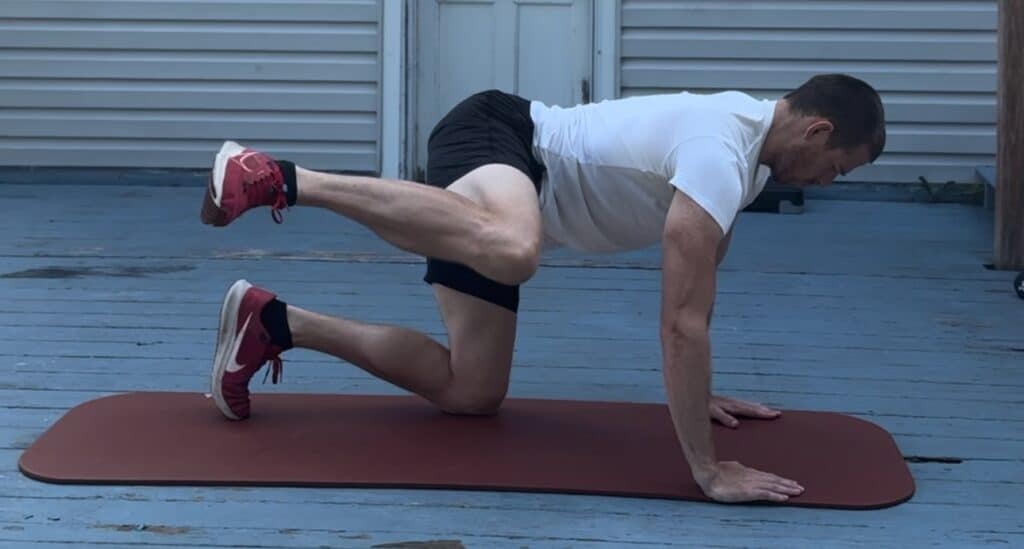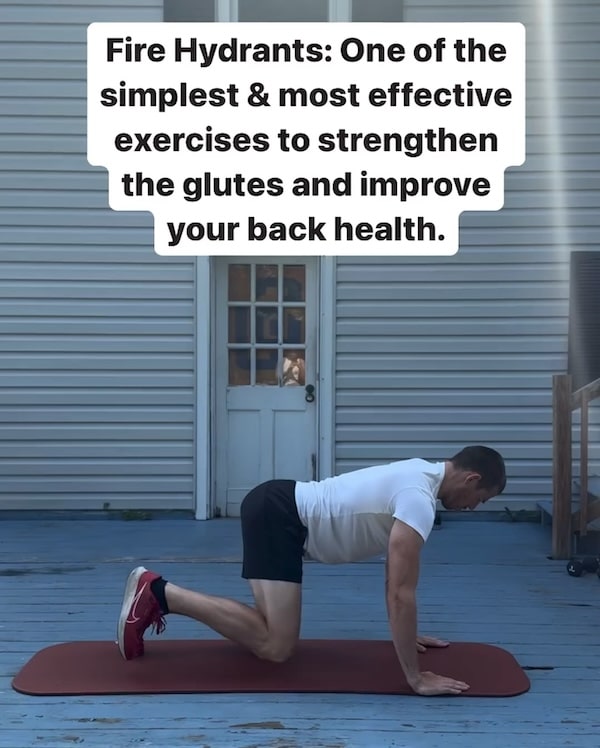Fire Hydrant Exercise: Benefits, Muscles Worked, How to Do
The fire hydrant exercise is a deceptively simple bodyweight movement that effectively targets the glutes and hip muscles, especially the often-neglected gluteus medius.
It’s humorously named because the motion resembles a dog lifting its leg next to a fire hydrant, but despite the silly image, this exercise delivers real benefits for hip stability, core strength, and lower-body alignment.
What makes the fire hydrant exercise special is that it trains hip abduction, which means moving the leg away from the midline of the body.
This movement strengthens the side of the hips and outer glutes, which are areas that can weaken easily if you sit for long periods or primarily perform forward-and-back exercises like squats and deadlifts.
As a 6’10” professional basketball player, I rely on the fire hydrant exercise to keep my hips mobile and my glutes strong enough to support my back.
When you’re as tall as I am, healthy hips and glutes are key for absorbing impact, staying balanced, and preventing nagging lower back pain.
Whether you’re an athlete, a weekend warrior, or just want better posture and stronger hips, adding the fire hydrant exercise to your routine can make a big difference!
What Is the Fire Hydrant Exercise?
As I explained before, the fire hydrant exercise is a bodyweight hip abduction movement designed to activate and strengthen the gluteus medius, gluteus minimus, and hip stabilizer muscles.
Named for the way a dog lifts its leg near a fire hydrant, this exercise involves lifting one knee out to the side while maintaining a tabletop position on all fours.
Unlike traditional squats or lunges, the fire hydrant targets lateral hip muscles that often go underdeveloped in standard lower-body training.
By isolating these smaller glute muscles, the movement improves hip mobility, develops pelvic stability, and corrects muscular imbalances that contribute to knee and lower back pain (Selkowitz et al., 2013).
The fire hydrant is easy to perform anywhere, requires no equipment, and can be scaled with bands or added resistance.
For taller athletes or those with long limbs, like myself, this simple movement plays a crucial role in preventing hip tightness and back strain that can result from repetitive running, jumping, or prolonged sitting.
Benefits of the Fire Hydrant Exercise: What Does the Fire Hydrant Exercise Do?
The fire hydrant exercise is highly effective for developing the gluteus medius muscle, a critical component for hip stability and overall lower body function.
Whether you’re aiming to prevent injuries, improve athletic performance, or develop better posture, the fire hydrant exercise offers multiple benefits that are essential for a well-rounded fitness routine.
Hip Stability
The fire hydrant exercise primarily targets the gluteus medius, a muscle on the side of the hip essential for pelvic stability.
Strong glutes stabilize the hips during movements such as walking, running, and pivoting, which directly improves balance and reduces the risk of hip and lower body injuries.
This makes it a key exercise for hip stability that benefits athletes and fitness enthusiasts alike.
Injury Prevention
Weak or imbalanced glutes are often linked to common injuries like knee pain, iliotibial (IT) band syndrome, and lower back strain.
The fire hydrant exercise strengthens the gluteus medius, reinforcing hip stability and helping to protect the knees and lower back from excessive strain.
Improved hip stability also ensures better movement mechanics, which is crucial for preventing overuse injuries in the lower body.
Improved Athletic Performance
Strong glutes play a vital role in athletic performance, contributing to powerful movements and efficient biomechanics.
By focusing on the gluteus medius, the fire hydrant exercise supports greater power output and allows for more effective energy transfer during running, jumping, and directional changes.
For taller athletes, this exercise helps reduce lower back strain, which is common with long limbs and a larger frame (Jeong et al., 2015).
This makes the fire hydrant exercise an excellent movement for any athlete focused on optimizing power, speed, and agility.
Glute Hypertrophy
The fire hydrant exercise promotes gluteal hypertrophy, which can improve the appearance of firm and toned glutes.
Developing the glute muscles not only benefits aesthetics but also improves the functional support for hip and lower back alignment.
Building stronger glutes through fire hydrants can contribute to a balanced physique and healthier movement patterns, which benefit overall posture and spinal alignment.
Posture Support
Improved glute strength from the fire hydrant exercise supports a balanced posture by stabilizing the pelvis and promoting optimal spinal alignment.
For individuals with taller or larger frames, strong glutes are crucial for mitigating lower back strain and maintaining proper posture during both static and dynamic activities.
The fire hydrant exercise is particularly valuable for individuals looking to alleviate lower back discomfort and maintain proper alignment in daily life and during high-intensity activities.
Fire Hydrant Exercise Muscles Worked
By engaging multiple muscle groups, the fire hydrant exercise offers a comprehensive workout for the glutes, hips, and core, promoting improved balance, strength, and alignment in daily movements and athletic activities.
Gluteus Medius
The fire hydrant exercise is especially effective for engaging the gluteus medius, which plays a central role in hip abduction, or the movement of the leg away from the body.
This muscle is key for stabilizing the pelvis and supporting lower body alignment during various activities, such as walking, running, and lateral movements.
Strengthening the gluteus medius through fire hydrants can improve hip stability, reduce knee strain, and prevent hip and lower back discomfort.
Gluteus Maximus
While primarily targeting the gluteus medius, fire hydrants also recruit the gluteus maximus, the largest muscle in the glutes.
As the primary muscle responsible for extending the hip, the gluteus maximus contributes to movements like standing up, climbing, and jumping.
Engaging the gluteus maximus during the fire hydrant exercise helps build strength and power in the lower body, which is essential for athletic performance and injury prevention.
Gluteus Minimus
Supporting both the gluteus medius and maximus, the gluteus minimus also plays a significant role in stabilizing the hip joint as it aids in hip abduction and external rotation, helping to align and stabilize the pelvis.
Although a smaller muscle, the gluteus minimus is critical for hip stability and can be activated with exercises like fire hydrants to enhance hip mobility and balance.
Abdominals and Obliques
The fire hydrant exercise engages the core muscles, including the abdominals and obliques, to maintain balance and control throughout the movement.
These core muscles work to stabilize the torso and prevent excessive rotation, ensuring that the pelvis remains aligned.
Activating the core in this way not only supports proper form during the exercise but also helps build core stability, which is essential for improving overall posture, athletic performance, and injury resistance.
How to Do Fire Hydrants

- Start on the floor on your hands and knees in a tabletop position, with your wrists directly under your shoulders and your knees under your hips.
- Brace your core by gently tightening your abdominals to keep your torso stable and prevent twisting during the movement.
- Keeping your knee bent at a 90-degree angle, lift one leg out to the side until your thigh is parallel to the ground or as high as your hip mobility allows.
- Pause at the top for one or two seconds and squeeze your glutes to maximize muscle engagement while keeping your back flat.
- Lower your leg back down with control to the starting position, complete your desired reps on one side, then switch to the other leg.
Fire Hydrant Exercise Progressions
Adding the fire hydrant exercise to your training routine can dramatically improve glute and hip strength, reinforce pelvic stability, and improve functional mobility.
These adaptations do more than boost athletic performance; they also make daily movements safer and more efficient by supporting proper lower-body mechanics and spinal alignment.
Personally, prioritizing back and hip health has been essential for sustaining my career on the court.
The fire hydrant remains one of my foundational movements for building strength where it matters most.
Once you’ve mastered the standard version with excellent control, you can advance to more challenging variations that keep your muscles adapting.
Banded Fire Hydrants
Looping a mini resistance band around your thighs adds constant lateral tension, increasing the workload on the gluteus medius and minimus.
This added challenge promotes greater muscle activation, improved hip stability, and better neuromuscular control.
Hip Controlled Articular Rotations (Hip CARs)
Controlled Articular Rotations (CARs) are a deliberate mobility drill designed to take a joint through its fullest possible range of motion while maintaining muscular tension and control.
The idea is to isolate the joint, in this case, the hip, and slowly move it through its available range of motion without compensating with other parts of the body.
This teaches your brain and muscles to access, strengthen, and control end ranges that often get neglected in traditional training.
When performing Hip CARs, you’re not just stretching; you’re actively building strength and stability around the joint, which improves functional mobility, helps prevent stiffness, and protects against injuries by making your hips more resilient and adaptable during real-life movements.
To perform hip CARs, begin in a tabletop position, draw your knee toward your chest, then sweep it out to the side and rotate it behind you in a slow, circular motion.
This progression builds active hip mobility, strengthens the deep hip rotators, and trains the hip joint to move efficiently in all directions.
How Often Should You Do the Fire Hydrant Exercise?
For most people, performing the fire hydrant exercise 2 to 3 times per week is ideal for building and maintaining hip strength, glute activation, and mobility.
This frequency strikes a good balance between challenging the muscles and giving them enough time to recover and grow stronger.
If you’re an athlete or have specific goals like improving hip stability for squats, running, or jumping, you can safely add fire hydrants to your warm-up or accessory work more often, even daily, as long as your volume and intensity stay moderate and you maintain proper form.
Consistent practice is more important than high volume.
Focus on controlled reps, full range of motion, and progressive overload (such as adding a resistance band) to continue seeing results without overworking your hips.
Read Next: Best Posterior Chain Exercises
This website does not provide medical advice. This website site does contain affiliate links, and purchases may earn a commission.
Read my Medical Disclaimer, Review Disclaimer, and Publishing Policies for more details. Use of this site indicates acceptance of these terms.



